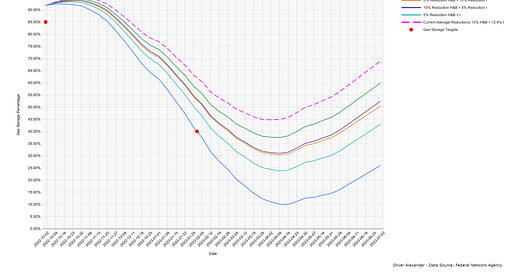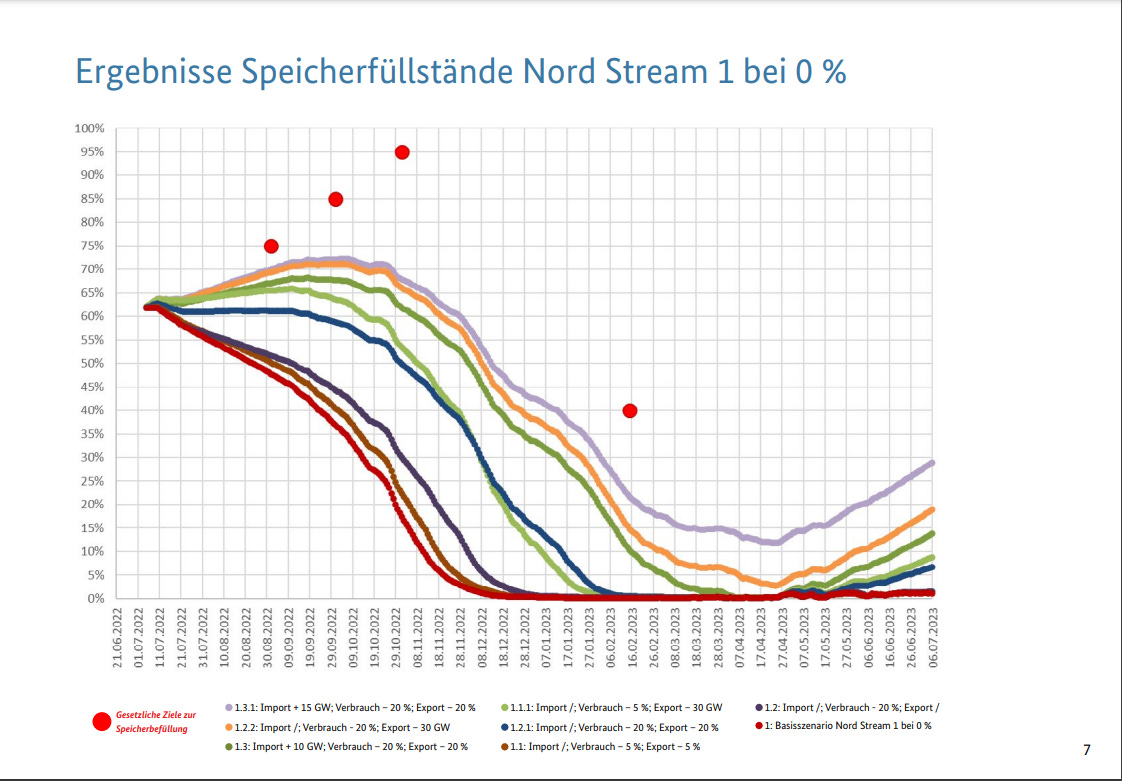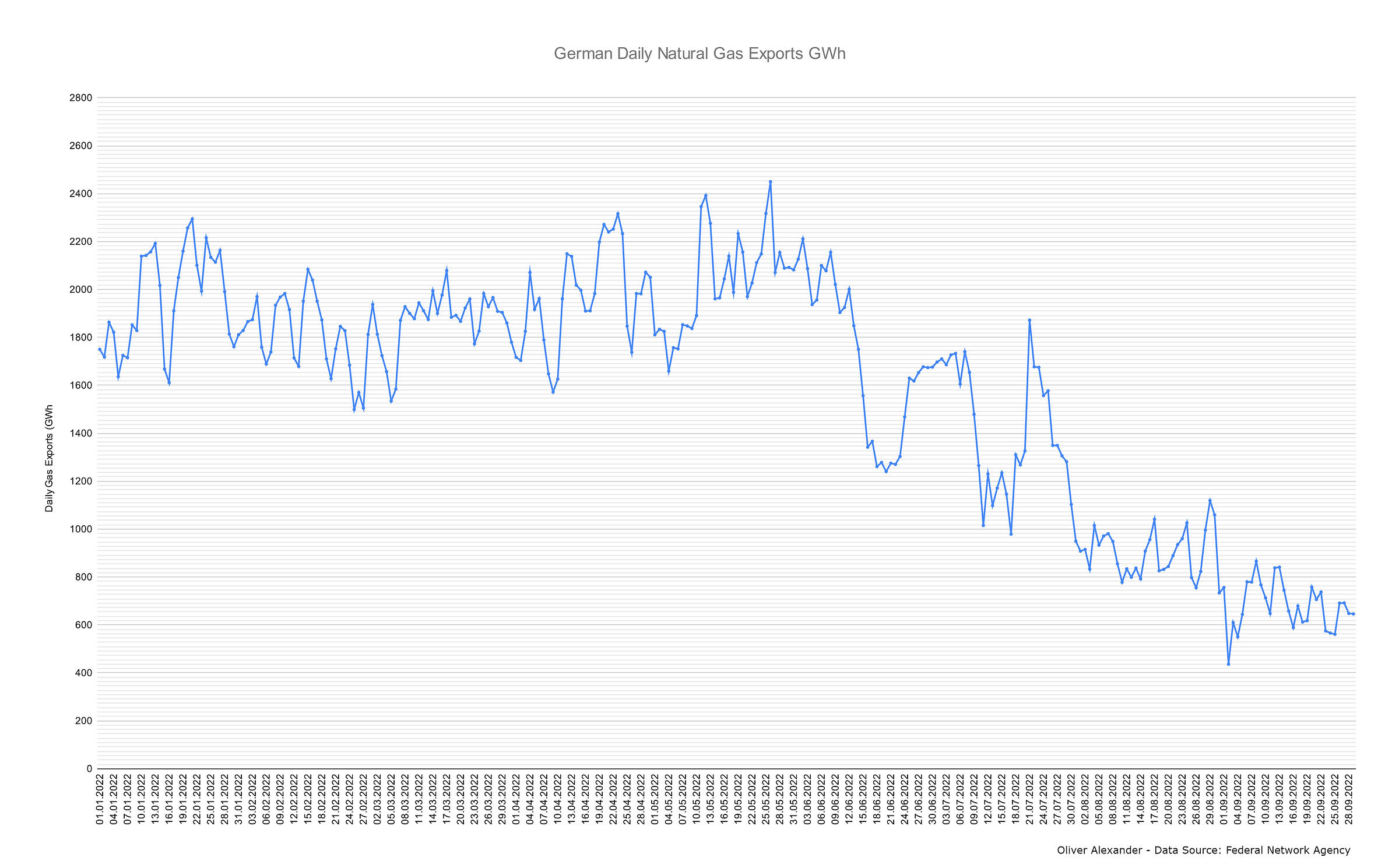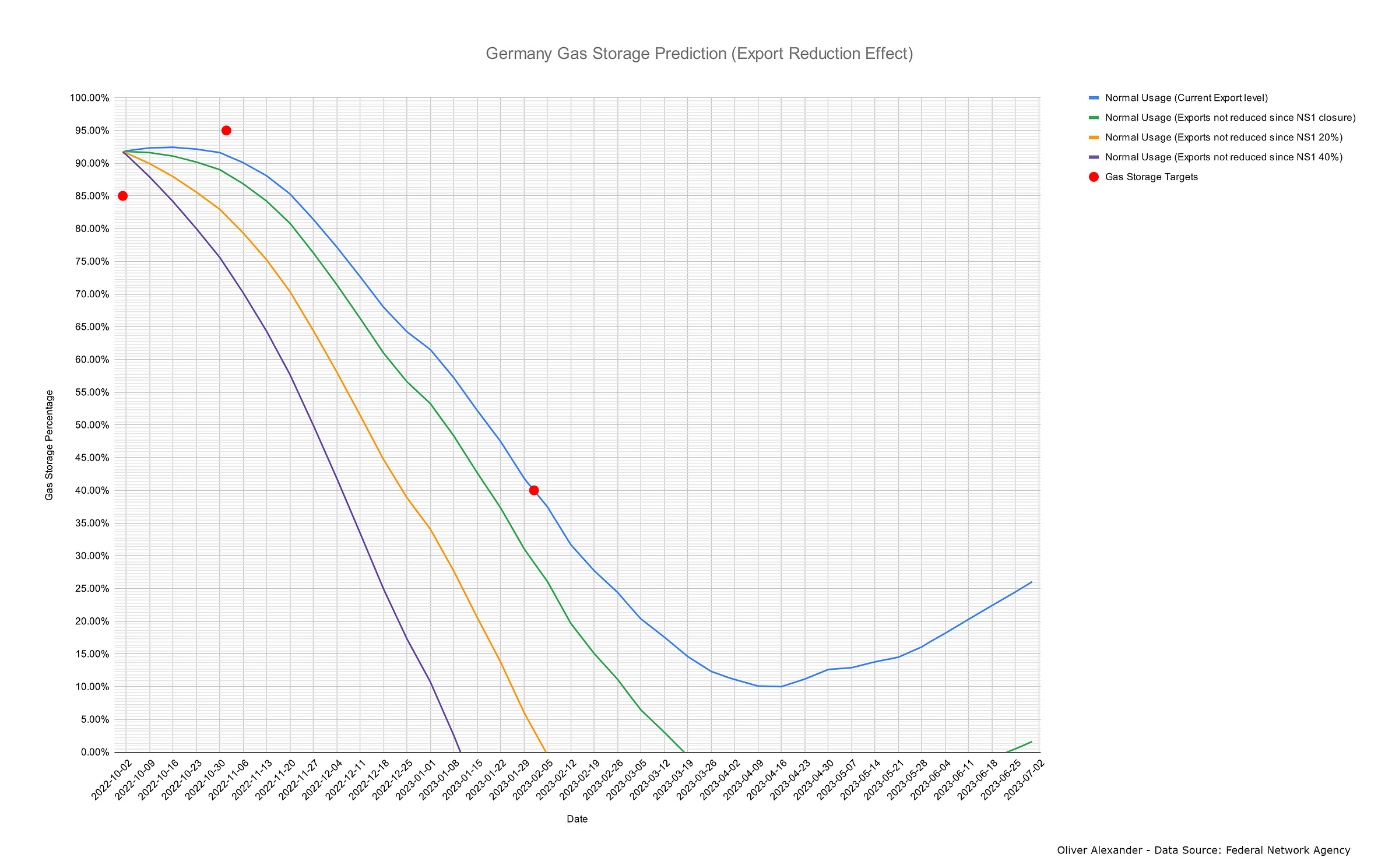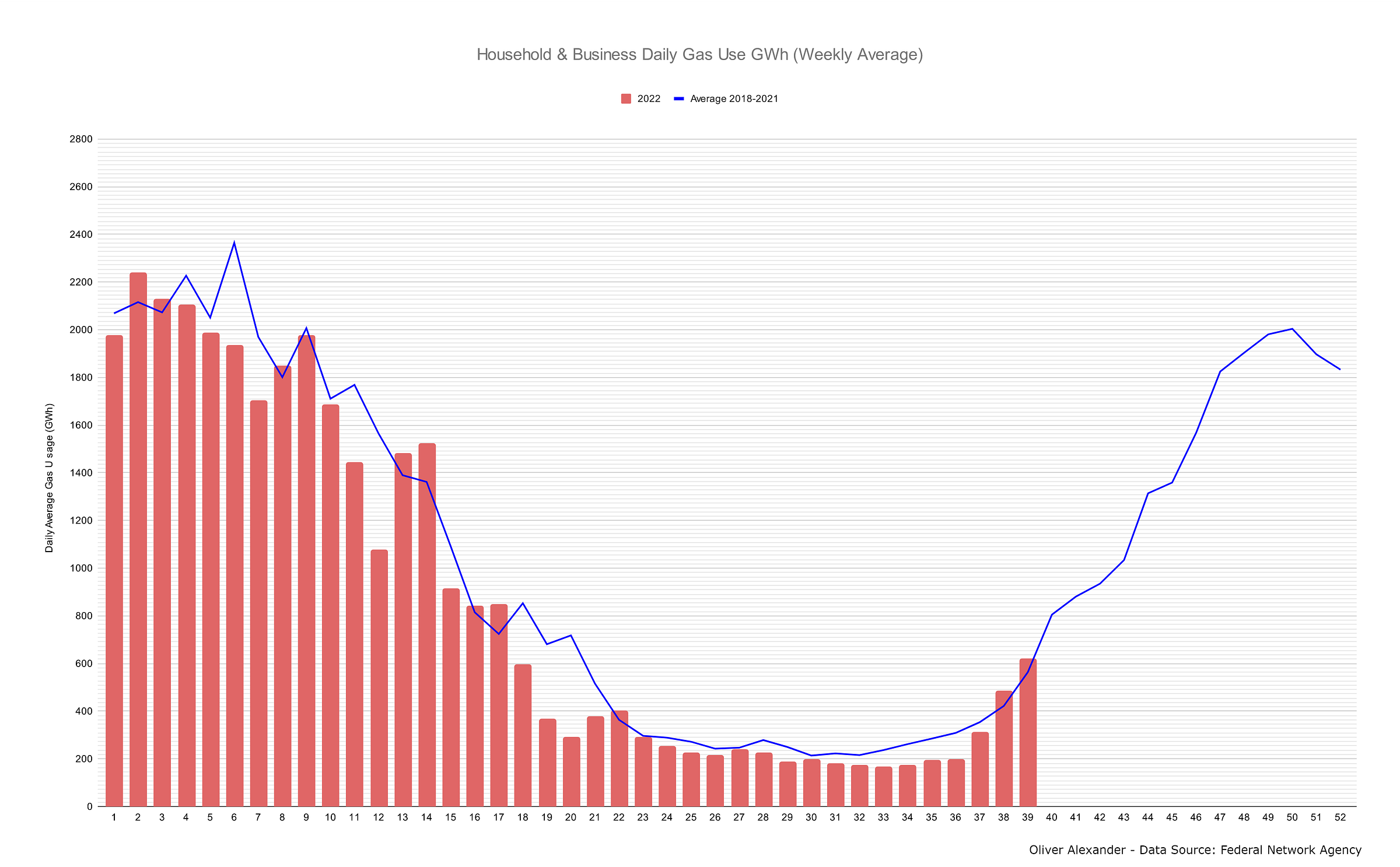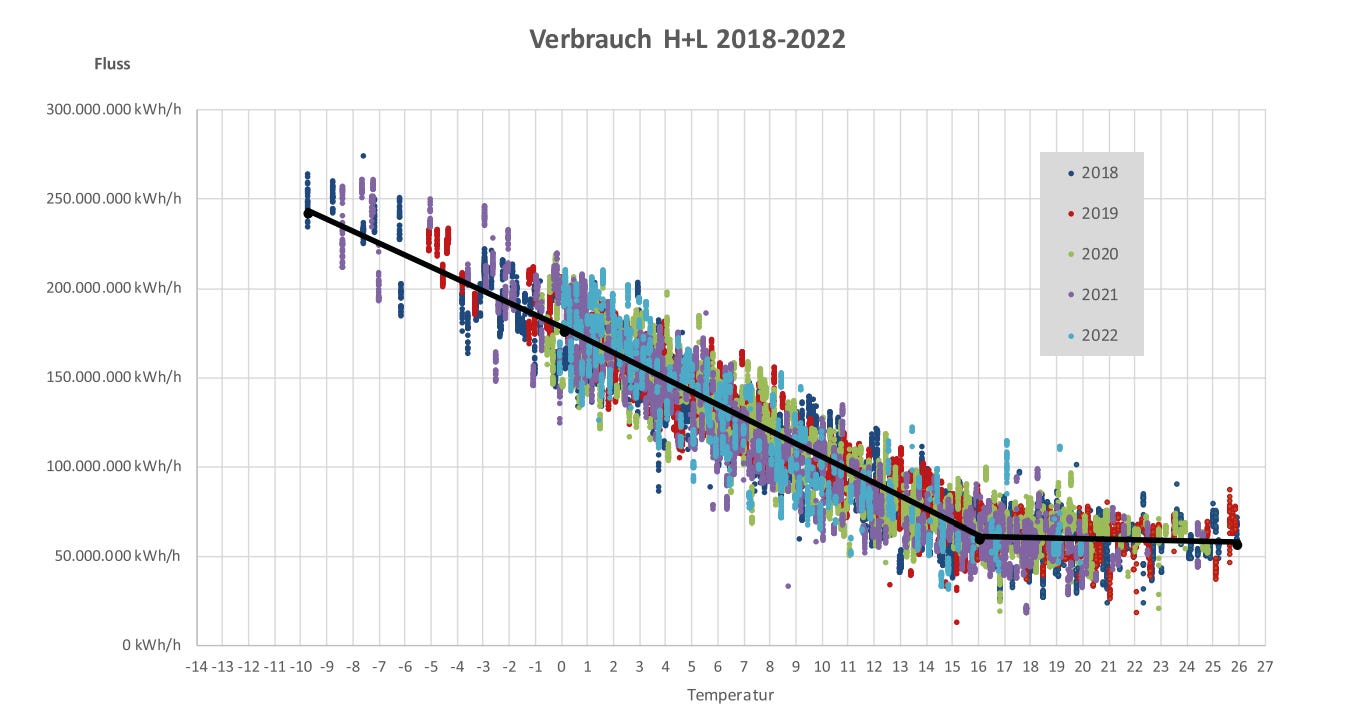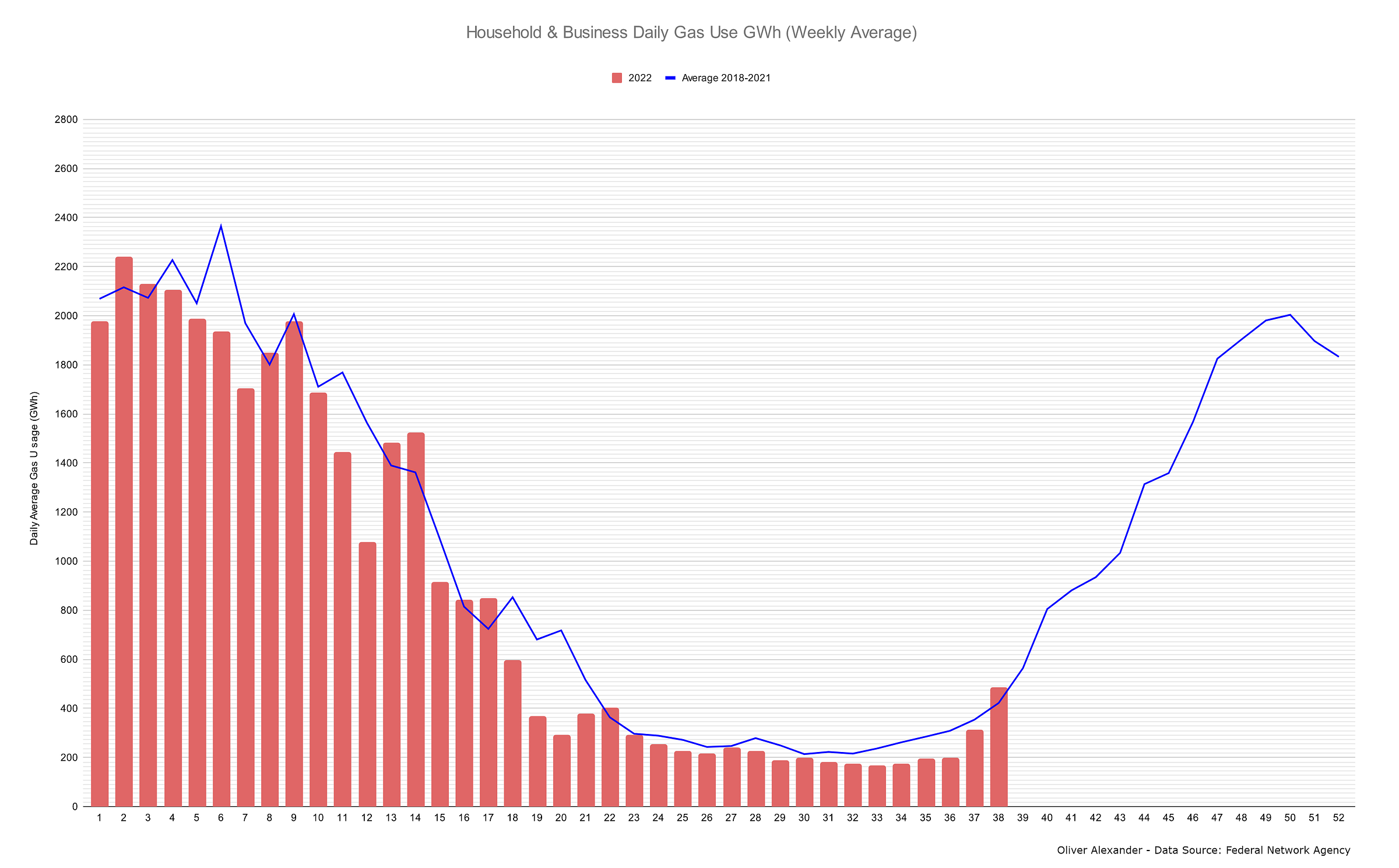Germany’s Gas Supply Looking Better Than Expected This Winter
A lot has changed since the German Federal Network Agency released natural gas supply scenarios on August 3rd. I have updated the scenarios with current data and they paint a positive picture.
On April 30th 2022 the Gas Storage Act went into effect in Germany. This set forth a series of goals / targets for gas storage fill levels in Germany. Initially these goals were:
October 1st: 80%
November 1st: 90%
February 1st: 40%
These targets were enacted to help ensure that Germany would both have sufficient gas supply to last this winter, but also improve the ability to have sufficient gas supply for next winter. Gas storage levels were at an all time low after the 21/22 winter, which was a factor in the current gas crisis. On July 27th the targets were updated and an interim target for September 1st was added.
September 1st: 75%
October 1st: 85%
November 1st: 95%
February 1st: 40%
The reasoning for these updated targets was given by Dr Robert Habeck, the German Minister for Economic Affairs and Climate Action.
“The Federal Government is doing all it can to continue to uphold security of supply. We have made considerable progress in recent months thanks to our concentrated and resolute action. Nevertheless, the situation remains tense, so we are stepping up our efforts and again increasing the storage level requirements. It’s clear that the gas reservoirs need to be full. We’re doing our utmost to make this happen.”
On August 3rd the German Federal Network Agency (Bundesnetzagentur) published a document with a prognosis for three different natural gas supply scenarios dependent on the amount of natural gas Germany would continue to receive through the Nord Steam 1 pipeline. The three scenarios were as follows:
Scenario 1: The Nord Stream 1 pipeline would supply no gas to Germany going forward.
Scenario 2: The Nord Stream 1 pipeline would continue to supply 20% of its maximum capacity to Germany
Scenario 3: The Nord Stream 1 pipeline would continue to supply 40% of its maximum capacity to Germany
Due to the recent sabotage of the Nord Stream 1 pipeline, scenarios 2 & 3 are completely out of the picture. One of the two strings of the Nord Stream 2 pipeline is still intact and could theoretically be capable of supplying up to 50% of the Nord Stream 1 pipeline’s maximum capacity, but due to a wide array of political and legislative factors the chances of this ever happening are infinitesimally small.
Above are the possible consumption based outcomes within “Scenario 1” of the model as presented by the German Federal Network Agency. As can be seen, not a single of the outcomes results Germany reaching their gas storage targets this year prior to winter or the target of having 40% of the total working gas volume remaining in storage by February 1st 2023.
The only consumption scenarios that avoided completely running out of natural gas were the following two :
Increase import by 15 GW - Reduce consumption by 20% - Reduce exports by 20%
Reduce consumption by 20% - Reduce exports by 30GW
Even with these measures, both of these consumption scenarios missed the February target, leaving only 20% and 15% left in storage on February 1st respectively.
In reality while natural gas from the Nord Stream 1 pipeline stopped flowing to Germany, it did continue at 20% for a period beyond the start of the scenario above. The Nord Stream 1 pipeline did not completely shut down until August 31st, which aided in putting Germany in a better situation that the above scenario shows.
Due to the multitude of major events since the Federal Network Agency released their scenarios over two months ago, I decided to create a new set of scenarios in an attempt to provide an updated and more accurate outlook on the German Gas Situation.
Firstly, their most aggressive consumption scenarios utilized a drop in German natural gas exports of 20%. Since the closing of the Nord Stream 1 pipeline, German natural gas exports have in fact dropped to an average daily value of 700 GWh. This is a drop of 50% from the average daily value of 1400 GWh in July when their initial model starts. It is also a drop of 65% from the start of 2022.
The reduction in Germany’s gas exports will play a major part in the Germany’s ability to meet its gas storage targets. As can be seen in the graph below, the effect of lowering the exports alone can potentially allow Germany to reach the February 2022 target while maintaining a gas usage inline with the average gas usage from 2018-2021. Had Germany not reduced its gas exports each time the flow through the Nord Stream 1 pipeline was reduced, the situation would have looked a lot more dire for Germany and severe gas saving measures would need to be enacted.
The graph below shows the scenarios I have created for the gas supply situation in Germany from October 1st 2022 to the beginning of July 2023. The “Normal Usage” is the same line as shown on the above export reduction graph. This scenario assumes that German gas exports stay around the current levels, heavily reduced from earlier in the year. On top of this though there is no usage reduction in gas compared to the average gas usage data over the past 4 years.
The next four scenarios assume different reductions in the gas usage by customers classed as “Household & Business” and “Industry”. “Household & Business” customers are defined by an annual gas usage of below 1.5 GW while “Industry” are customers with a annual gas usage above this. Unsurprisingly the larger the reduction in consumption among these customers, the more likely Germany is to reach its targets.
The final scenario takes into account the current average reduction in gas usage from the norm among both “Household & Business” and “Industry” customers. So far this year, “Household & Business” has on average used 13% less gas than an average year, while “Industry” customers are down 12.4% from the norm.
In the past two weeks the household gas usage numbers have been slightly above the 2018-2021 average (14.55% Week 38 and 9.57% Week 39). The head of Germany’s Network Regulator responded to this on Thursday October 6th by stating:
"The numbers for that week are thus very sobering, without significant savings in the private area of consumption, it will be difficult to avoid an emergency situation in winter."
This is a very alarmist reaction to these minor increases in Household and Business gas consumption. There are a few factors that need to be considered.
As we have hit the end of September, a large number of people will turn on heating for the first time, the date for the start of this is heavily weather dependent.
While the percentage increase over average for Week 38 and Week 39 looks large, measured in actual GWh’s a day it is a minor jump as gas usage in Germany during these weeks is still only at around 1/4 of peak usage. In week 38 Households and Business’ used 483 GWh per day up from 422 average, an increase of 61 GWh per day. In Week 39 they used 618 GWh per day up from 564 average, an increase of 54 GWh per day.
In contrast, the average usage for Week 4 at the end of January is 2,227 GWh per day and the difference between the minimum and maximum value in the 2018-2021 average is 891 GWh per day.At this time we are currently talking about such minimal fluctuations that have no real impact in the long term. So far there is no indication that the gas usage will remain above average, especially not the 20% above average as has been stated in some media outlets. It is a tiny fluctuation which has already dropped form 61GWh per day to 54 GWh per day, I expect it to fully disappear in a few weeks as weather over Germany averages out.
Currently the US National Oceanic and Atmospheric Administration (NOAA)’s models forecast a winter in Germany that will be between 1-2°C above the norm. This is a key factor which I expect will cause the Household and Business gas usage to fall below the 2018-2021 average for the winter. Household and Business gas usage is extremely volatile and for some weeks in the winter the difference between the minimum and maximum value in the 2018-2021 average has been 1500 GWh per day due to temperature fluctuations.
These scenarios show that with the current gas supplies and gas saving measures there is little to no danger of Germany running out of gas this winter. While a harsh winter will of course inevitably increase gas usage and may again make the situation precarious for Germany, with an average winter supplies should meet the targets set forth by the Gas Storage Act.
I intend to keep updating the scenarios as we go forward and as we get more usable data.
Below I will go into more detail regarding the specific factors that are included in my scenarios:
The first important factor to include in the modelling of the scenario is Germany’s gas usage. Here I used the two separate categories also used by the Federal Network Agency instead of just overall gas usage, as it allows for independent changes in “Household & Business” and “Industry” usage. In the event of a cold winter, it is also expected that “Household & Business” may increase more than “Industry” usage as more gas is used to heat homes. As is shown in a graph by the Federal Network Agency in this document, as the temperature drops gas use increases quite rapidly.
The following two graphs show the 2022 gas usage as well as the average gas usage for the two gas customer categories. This shows that both categories are averaging around 12-13% savings over the average year. It also shows how much more volatile the “Household & Business” category’s usage is as it is more susceptible to temperature changes.
Germany also produces some natural gas averaging around 120 GWh per day. This production has remained steady for a while looks to continue to remain this way in the short term.
While German natural gas imports have dropped of dramatically in the past few months, all of the drop has come due to the cut off of Russian gas. Germany’s imports from other countries have remained stable and are set to get a small increase at the start of 2023.

